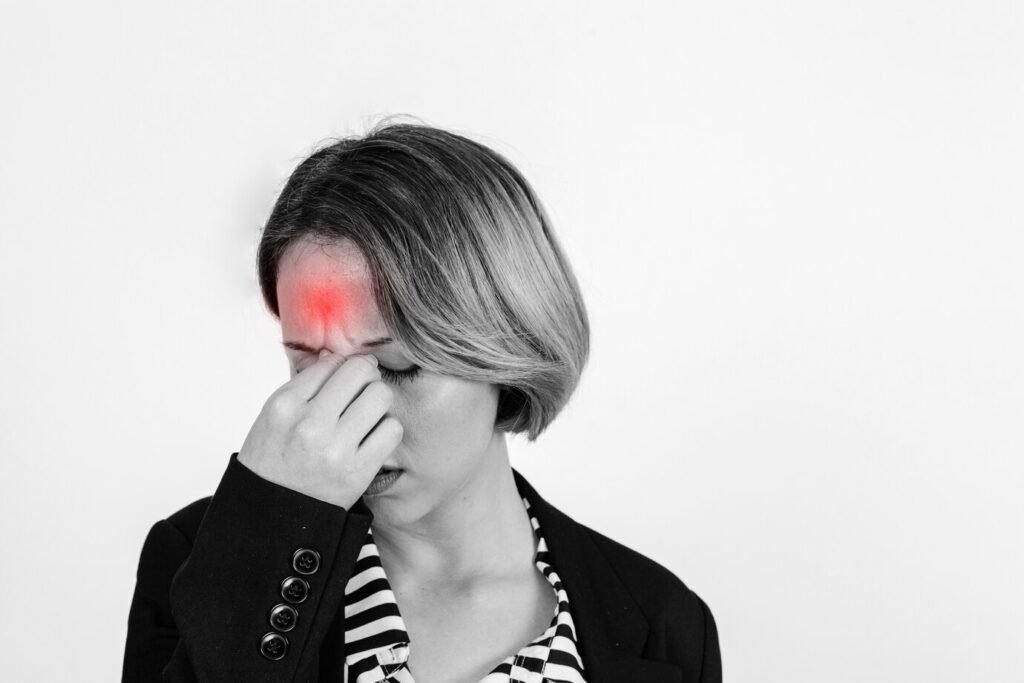Today we will explore the various types of headache symptoms. Headaches are a common ailment that many people experience at some point in their lives. While they can range from mild discomfort to debilitating pain, understanding headache symptoms is crucial for effective management and headache treatment. In this article, we will explore the various types of headaches, their headache symptoms, and actionable insights to help you alleviate pain. By the end of this guide, you will have a clearer understanding of headaches and how to address them effectively.

Table of Contents
What Are Headaches?
Headaches are defined as pain or discomfort in the head, scalp, or neck. They can vary significantly in intensity, duration, and frequency. According to the World Health Organization (WHO), nearly half of adults aged 18 to 65 have experienced a headache in the last year. This statistic underscores the prevalence of headaches in our daily lives.
Types of Headaches
Headaches can be categorized into two primary types: primary headaches and secondary headaches.
- Primary Headaches: These are not caused by an underlying medical condition. Instead, they are standalone disorders. The most common types include:
- Tension Headaches: Often described as feeling like a tight band that wraps around the head, tension headaches are commonly experienced and typically range from mild to moderate in terms of intensity. These headaches can vary in duration, lasting anywhere from as short as 30 minutes to as long as several days, and they may arise from a variety of factors including stress, poor posture, or muscle strain.

- Migraine: Migraines are particularly notorious for their debilitating headache symptoms, which are often characterized by intense, throbbing pain that can be quite severe. The duration of a migraine can be anywhere from just a couple of hours to several days, and they frequently come with additional symptoms such as nausea, vomiting, and an increased sensitivity to light and sound. Many individuals who experience migraines find that these attacks can be triggered by certain foods, hormonal changes, or environmental factors.

- Cluster Headaches: Cluster headaches are known for being among the most severe types of headaches, typically occurring in cyclical patterns or clusters that can last for weeks or months at a time. The pain is usually intense and is often concentrated on one side of the head, frequently around the area of the eye. These headaches are distinct not only for their severity but also for the recurring nature of the attacks, which can lead to significant distress for those who suffer from them.

- Secondary Headaches: These are headache symptoms of another underlying condition, such as:
- Sinus Headaches: These types of headaches are frequently linked to sinus infections, and they typically manifest with significant facial pain as well as a feeling of pressure in the surrounding areas. Individuals suffering from sinus headaches may also experience discomfort in their forehead, cheeks, and even behind the eyes, amplifying the overall sensation of distress. The inflammation and congestion resulting from a sinus infection can exacerbate these headaches, making them particularly unpleasant during episodes of illness.
- Cervicogenic Headaches: Cervicogenic headaches are characterized by their origin in the neck, where various issues such as muscle tension, poor posture, or spinal disorders can trigger pain. These headaches often manifest as discomfort that radiates from the neck to the head and can be accompanied by stiffness and limited range of motion. Understanding the connection between neck problems and headache occurrence is essential for effective headache treatment and management, as addressing underlying neck issues can lead to relief from the associated headaches.
- Medication Overuse Headaches: Medication overuse headaches arise as a consequence of the frequent and often excessive use of pain of headache relief medications. Individuals who regularly rely on over-the-counter or prescription headache relief for their headaches may inadvertently trigger a cycle of recurring headaches known as rebound headaches. This situation occurs when the body becomes accustomed to the medications, leading to an increase in headache frequency and intensity. Recognizing the signs of medication overuse headaches is vital, as it can guide individuals toward more appropriate management strategies.

Common Headache Symptoms
Understanding the headache symptoms can help in identifying the type and seeking appropriate headache treatment. Here are some common symptoms associated with different types of headaches:
Tension Headache Symptoms
- Mild to moderate pain, often described as a tightness or pressure around the forehead.
- Tenderness in the scalp, neck, and shoulder muscles.
- Duration can range from 30 minutes to several days.
Migraine Headache Symptoms
- Intense, throbbing pain, often on one side of the head.
- Nausea and vomiting.
- Sensitivity to light and sound.
- Aura symptoms, such as visual disturbances, can occur before the headache.
Cluster Headache Symptoms
- Severe pain, typically on one side of the head, often around the eye.
- Episodes can occur multiple times a day for weeks or months, followed by periods of remission.
- headache symptoms may include nasal congestion or runny nose on the affected side.
Sinus Headache Symptoms
- Deep, constant pain in the cheekbones, forehead, or bridge of the nose.
- Accompanied by nasal congestion, fever, or facial swelling.
Cervicogenic Headache Symptoms
- Pain that starts in the neck and radiates to the head.
- Often accompanied by neck stiffness or pain.
When to Seek Medical Help
While most headaches are not serious, certain headache symptoms warrant immediate medical attention. Seek help if you experience:
- A sudden, severe headache (often described as a “thunderclap” headache).
- Headaches that worsen over time or change in pattern.
- Neurological headache symptoms, such as confusion, difficulty speaking, or weakness.
- Headaches following a head injury.
Actionable Tips for Managing Headache Symptoms
Effectively managing headaches requires a multifaceted approach that encompasses a variety of strategies, including lifestyle changes, the use of home remedies, and, when necessary, seeking medical intervention. It is important to recognize that headaches can be influenced by numerous factors, and addressing these can lead to significant headache relief. Below are some practical and actionable tips designed to help alleviate the uncomfortable headache symptoms associated with headaches:
1. Stay Hydrated
Dehydration is a widely recognized trigger for headaches, which can make daily activities quite uncomfortable. To combat this issue, it is essential to make a conscious effort to drink plenty of water consistently throughout the day. It is generally recommended to aim for at least eight glasses of water daily to stay properly hydrated. Moreover, it is important to increase your fluid intake even further during particularly hot weather or when engaging in physical activities that cause sweating. Staying adequately hydrated not only helps prevent headaches but also supports overall health and well-being.

2. Maintain a Regular Sleep Schedule
Inadequate or irregular sleep patterns can significantly lead to an increase in both the frequency and intensity of headaches. To mitigate this issue, it is important to strive for a total of 7 to 9 hours of high-quality sleep every night. Additionally, it is beneficial to maintain a consistent sleep schedule by going to bed and waking up at the same times each day, as this helps regulate your body’s internal clock and can further prevent headache occurrences. By prioritizing good sleep hygiene, you can work towards reducing headache symptoms and improving your overall well-being.

3. Practice Stress Management Techniques
Stress is a major contributing factor that can lead to the onset of tension headaches in many individuals. To help combat this issue, it is beneficial to integrate various relaxation techniques into your everyday routine. Consider activities such as yoga, which not only promotes physical flexibility but also fosters mental tranquility. In addition to yoga, practicing meditation can be a powerful tool for calming the mind and reducing stress. Furthermore, engaging in deep breathing exercises can significantly enhance your ability to relax and alleviate tension. By making these practices a regular part of your life, you can effectively help manage stress and potentially reduce the frequency and intensity of tension headaches.
4. Monitor Your Diet
Certain foods and beverages can trigger headaches. Common culprits include:
- Caffeinated drinks
- Alcohol
- Aged cheeses
- Processed meats
Keep a food diary to identify potential triggers and adjust your diet accordingly.
5. Use Over-the-Counter Headache Relief
For mild to moderate headaches, using over-the-counter headache relief medications can often provide significant headache relief. Common options include ibuprofen or acetaminophen, both of which have been shown to be effective for alleviating headache pain. It is important, however, to use these medications responsibly. Overusing them can lead to a condition known as medication-overuse headaches, which can complicate your situation further. Therefore, while these medications can be helpful when needed, it is crucial to monitor your usage and avoid taking them too frequently in order to prevent any potential complications.
6. Apply Cold or Warm Compresses
Depending on the specific type of headache you are experiencing, applying either a cold or a warm compress can be quite effective in providing headache relief from the discomfort. Cold compresses are particularly useful as they can help numb the pain sensations, making you feel more comfortable and easing the throbbing. On the other hand, warm compresses can be beneficial as they tend to relax tense muscles in the neck and head areas, which can often contribute to headache severity. Choosing the appropriate temperature for the compress based on your headache symptoms can enhance your overall relief experience.
7. Seek Professional Help
If you experience headaches that continue for an extended period or become more severe over time, it is important to seek advice from a healthcare professional. They will have the expertise to evaluate your condition accurately and may suggest a variety of headache treatment options suited specifically to your needs. These could include prescription medications that are effective in managing pain, physical therapy sessions designed to alleviate tension, or various other therapeutic approaches that cater to your individual health requirements.
Conclusion
Understanding headache symptoms is essential for effective management and headache treatment. By recognizing the type of headache and its associated headache symptoms, individuals can take proactive steps to alleviate pain and improve their quality of life. Remember, while headaches are common, they should not be ignored, especially if they change in pattern or severity. By following the actionable tips outlined in this guide, you can better manage your headaches and seek appropriate care when necessary.
Frequently Asked Questions (FAQ)
1. What is the most common type of headache?
The most prevalent form of headache that people experience is known as the tension headache. This particular type of headache is characterized by a range of pain that typically falls within the mild to moderate spectrum. Individuals suffering from this type of headache often report a sensation of tightness or pressure that encircles the head, which can contribute to discomfort and an overall feeling of unease.
2. How can I differentiate between a migraine and a tension headache?
Migraines are typically characterized by their greater intensity, often leading to debilitating pain that can significantly affect daily activities. In addition to the severe headache, migraines may also bring about other distressing headache symptoms, such as nausea, vomiting, and heightened sensitivity to both light and sound, making it difficult for those affected to find headache relief or comfort. In contrast, tension headaches are generally less severe and are frequently described as producing a sensation akin to a tight band wrapping around the head, resulting in a more manageable level of discomfort that doesn’t usually incapacitate individuals in the same way.
3. Are there any natural remedies for headaches?
Certainly! Natural remedies, including ensuring that you stay well-hydrated, using various relaxation techniques to manage stress, and applying either cold or warm compresses to the affected area, can be effective in helping to relieve the discomfort associated with headache symptoms. These approaches offer a gentle and holistic way to address headaches without relying solely on medication. By incorporating these simple yet useful methods into your routine, you may find significant headache relief from the discomfort that headaches can cause.
4. When should I see a doctor for my headaches?
It is important to seek medical attention promptly if you encounter sudden and severe headaches that come on unexpectedly. Additionally, if you notice that your headaches are progressively worsening over time, this is another critical reason to consult a healthcare professional. Furthermore, you should be particularly vigilant for any neurological headache symptoms that may accompany your headaches, such as confusion, weakness, or any other unusual changes in your mental or physical state. Taking these symptoms seriously and getting the appropriate medical evaluation can be crucial for your health and well-being.
5. Can diet affect headaches?
Indeed, there are specific foods and beverages that have been known to provoke headaches in some individuals. To better understand which items may be contributing to this discomfort, maintaining a detailed food diary can be an effective strategy. By regularly recording what you eat and drink, you can more easily pinpoint any potential dietary triggers that might be leading to headache occurrences. This awareness allows you to make informed adjustments to your diet, potentially alleviating headache symptoms and improving your overall well-being.
By understanding headache symptoms and implementing effective management strategies, you can take control of your health and reduce the impact of headaches on your daily life.


